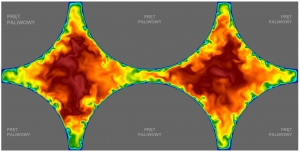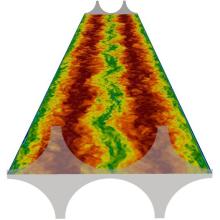The most accurate picture of the turbulent flows in the heart of a nuclear reactor
28-12-2023
Nuclear reactions heat the fuel rods in reactor cores. Reception of the heat generated in this way is critical for the safety of the reactors themselves and the efficiency of the steam turbines that generate electricity. Complex physical phenomena occurring during coolant flows between fuel rods can now be predicted faster and more accurately thanks to unique computer simulations carried out at the National Center for Nuclear Research in Świerk.
Three and a half years of 10,000 computing cores were required to run a computer simulation reproducing the turbulent flows of coolant and heat between tightly packed fuel rods in nuclear reactor cores. Unique calculations and a database of flow fields and temperatures built on their basis were carried out as part of a long-term scientific cooperation between the Dutch Nuclear Research & Consultancy Group (NRG) in Petten and the National Center for Nuclear Research (NCBJ) in Świerk. Importantly, the collected data can be used to reconstruct the hydro- and thermodynamic processes occurring in the flows inside reactors cooled by water, gas and even liquid metals.
An article summarizing the results of the project has just been published in the „International Journal of Heat and Mass Transfer”. PhD. Eng. Tomasz Kwiatkowski (NCBJ), co-author of the article, explains the essence of the research: „In modern reactors, nuclear fuel is inside fuel rods placed in special cassettes. Under the influence of nuclear reactions, these rods heat up and give off heat to the coolant flowing between them. Our intention was to simulate the flows of both coolant and heat inside the tightly packed fuel assemblies as closely as possible, taking into account the role of larger and smaller vortices. From the operational side, it was about creating a reference database that could be used in the future for faster calculations, simplified, but with our data significantly more accurate than before."
In physics, laminar, transient and turbulent fluid motions are described by the Navier-Stokes equations. Their Direct Numerical Simulation (DNS) is extremely time-consuming and, even when simulating flow around objects with simple geometry, requires the involvement of large computational clusters for months or even years. On a daily basis, therefore, simplified models of the RANS type (Reynolds Average Navier Stokes) are used, where the Navier-Stokes equations are averaged. Depending on the geometrical complexity of the simulated system, the results can then be obtained even within a few to a dozen or so days of cluster operation, but they must be treated with appropriate caution, taking into account the uncertainties resulting from the approximations used. A compromise in terms of both time-consuming calculations and accuracy of results, as well as the geometric complexity of the simulated systems, are LES (Large Eddy Simulation) models. Large vortices are calculated directly from the Navier-Stokes equations, while small vortices are calculated using simplified methods.
In Polish-Dutch simulations of coolant flows between fuel rods, the DNS approach was used, guaranteeing the highest accuracy of results. The rank of these simulations is particularly high because they provide information that would be extremely expensive, difficult or even impossible to obtain using experimental methods. In this situation, it is DNS-class computer simulations that become the most reliable source of information about what is happening with the coolant and heat inside the fuel rod assemblies.
In the calculations carried out at the Świerk IT Center, a three-dimensional flow of coolant flowing along six fuel rods located at short distances was modeled and analyzed. Their tight packing allows to increase the released power and is characteristic of both modern and newly designed nuclear reactors.
„The simulations lasted over three years, because as part of the model we built, we wanted to reproduce the real operating conditions of the fuel rods as faithfully as possible. So we had to wait for all scale turbulence in the numerical flow to fully develop. Only then could we start collecting information for the reference database,” says PhD. Eng. Kwiatkowski.
Properly performed calculations allowed the researchers to trace with exceptional accuracy the flows of both the coolant itself and the heat transferred to it from the fuel rods. Recreated, among others the formation of a path of vortices leading to the appearance of pulsations in the coolant flow, the consequence of which may be temperature pulsations. On the one hand, flow pulsations are beneficial because they increase the efficiency of heat exchange, thus reducing the risk of spot overheating of the fuel rods, but on the other hand, they can cause the rods to vibrate, which in turn can result in cracks that threaten their mechanical integrity. Thanks to simulations from Świerk, it was possible to determine the dominant frequency of these pulsations, which turned out to be 3.7 Hz.
The final result of the research project carried out by NCBJ and NRG is a publicly available reference database, intended for validation of calculations carried out using simplified methods RANS and LES. Thanks to the validation, it will be possible to build new correlations used in simplified models and to improve the existing turbulent models in order to even more accurately map flows and heat exchange in tightly packed fuel assemblies.
The Polish-Dutch research Was financed from the own resources of both involved scientific institutions.
SCIENCE PUBLICATIONS:
„Direct numerical simulation of flow and heat transport in a closely-spaced bare rod bundle.”
A. Mathur, T. Kwiatkowski, S. Potempski, E. M. J. Komen
International Journal of Heat and Mass Transfer 2023, 211, 124226
DOI: https://doi.org/10.1016/j.ijheatmasstransfer.2023.124226
ILLUSTRATIONS:
Fig. 1. Turbulent flow of coolant between fuel rods (flow direction perpendicular to the graphic surface). (Source: NCBJ/NRG)
Fig. 2. Coolant flow visualized in a section along the fuel rods. Visible sinusoidal vortex path. (Source: NCBJ/NRG)






